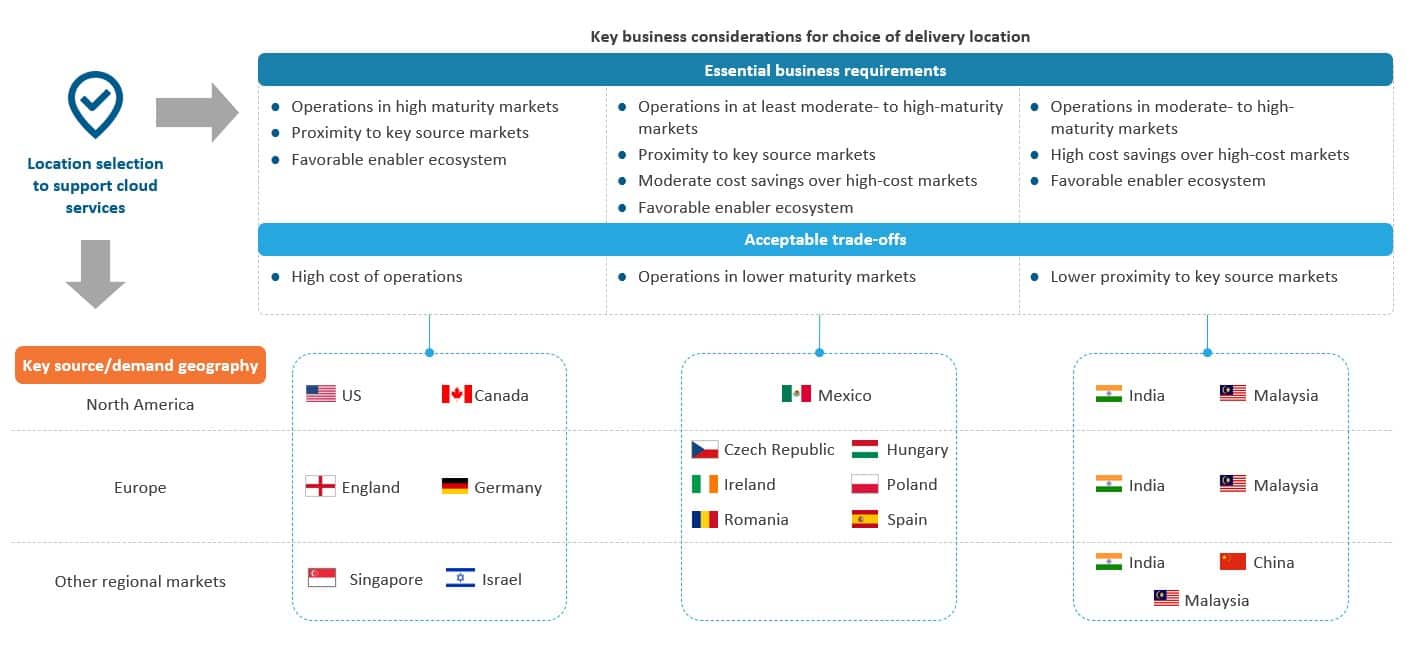Blog
Choosing Your Best-fit Cloud Services Delivery Location | Blog

While enterprises around the globe began their steady march toward cloud services well before the outbreak of COVID-19, the pandemic has fueled cloud adoption like never before. Following the outbreak, organizations quickly went digital to enable remote working, maintain data security, and ensure operational efficiencies. Globally, first quarter spend on cloud infrastructure services in 2020 increased 39% over the same period last year.
Given the new realities, as firms make long-term cloud investments, it is vital for them to understand the cloud landscape and how various regions and countries fare in comparison to each other as cloud destinations. In this blog, we evaluate and compare the capabilities of different geographies in delivering cloud services.
The Americas
North America is among the most mature geographies for cloud services delivery. The US and Canada offer excellent infrastructure, a mature cloud ecosystem, high innovation potential, a favorable business environment, and business-friendly rules and regulations. The US is the most mature location in North America, offering a large talent pool and high collaboration prospects due to the presence of multiple technology start-ups, global business services centers, and service providers. However, the cost of operations is significantly high, primarily driven by high labor and real estate costs.
In contrast, most locations in Latin America (LATAM) have less mature cloud markets and ecosystems. While they provide proximity to key source markets in the US and considerable cost savings as compared with established markets (60-80%), they offer low innovation potential, a relatively small talent pool, few government policies to promote cloud computing, and limited breadth and depth of cloud delivery. Mexico is a standout location in LATAM, scoring better than others on parameters such as quality of cloud infrastructure, size of talent pool, and business environment.
Europe
Europe provides a good mix of established and emerging locations for cloud services. Countries in Western Europe have a fairly robust infrastructure to support cloud services, with high cybersecurity readiness, sizable talent pools, high complexity of services, and robust digital agendas and cloud policies. England and Germany are the most favorable locations in the region, driven by a comparatively large talent pool accompanied by high innovation potential, excellent cloud and general infrastructure, and high collaboration prospects due to numerous technology start-ups and enterprises. However, high cloud-adoption maturity has markedly driven up operating costs and intensified competition in these markets.
Countries in Central and Eastern Europe (CEE) offer moderate cost savings (in the 50-70% range) over leading source locations in Western Europe. While they offer a favorable cloud ecosystem, talent availability, greater proximity to key source markets, and lower competitive intensity, they score lower on innovation potential, complexity of services offered, and concentration of technology start-ups and players. The Czech Republic is a prominent location for cloud services in the CEE, while Poland and Romania are emerging destinations.
Asia Pacific (APAC)
Most locations in APAC have high to moderate maturity for cloud services delivery due to the size of the talent pool and significant cost savings (as high as 70-80%) over source markets such as the US. For example, India offers low operating costs, coupled with a large talent pool adept in cloud skills and a significant service provider and enterprise presence. However, it scores lower on aspects such as innovation potential, infrastructure, and quality of business environment. Singapore is an established location that offers well-developed infrastructure and high innovation potential but also involves steep operating costs (40-45% cost arbitrage with the US). The Philippines, a popular outsourcing destination, has lower cloud delivery maturity given its low innovation potential and talent availability for cloud services.
Middle East and Africa (MEA)
Israel is an emerging cloud location in the MEA that has achieved high cloud services maturity, but that benefit is accompanied by high operating costs and low cost-savings opportunity (about 10-15%). Other locations in the region have moderate to low opportunity due to small talent pools and lower maturity in terms of cloud services delivery.
Choosing your best-fit cloud services delivery location
Our analysis of locations globally reveals that, while different locations can cater to the increasing cloud demand, there is no single one-size-fits-all destination. Instead, the right choice depends on several considerations and priorities:
- If operating cost is not a constraint and the key requirements are proximity to key source markets and a favorable ecosystem, the US, Canada, Germany, England, Singapore, and Israel are suitable locations, depending on the demand geography
- If you are looking for moderate cost savings, proximity to source markets, and a favorable ecosystem, with the acceptable trade off of operations in a relatively low maturity market, countries such as Mexico, the Czech Republic, Hungary, Poland, Ireland, Romania, and Spain are attractive targets
- However, if cost is driving your decision and proximity to demand geographies is not a priority, India, Malaysia, and China emerge as clear winners
The exhibit below helps clarify and streamline location-related decisions, placing an organization’s key considerations up front and identifying acceptable trade-offs to arrive at the best-fit locations shortlist.
Key considerations for choosing your cloud services delivery location

To learn more about the relative attractiveness of key global locations to support cloud skills, see our recently published Cloud Talent Handbook – Guide to Cloud Skills Across the Globe. The report assesses multiple locations against 15 parameters using our proprietary Enabler-Talent Pulse Framework to determine the attractiveness of locations for cloud delivery. If you have any questions or comments, please reach out to us at Hrishi Raj Agarwalla, Bhavyaa Kukreti, or Kunal Anand.